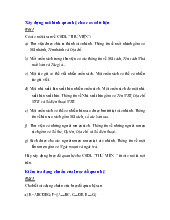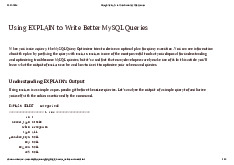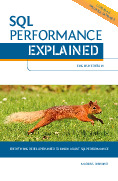



















Preview text:
Real-world consistency explained
or the chal enges of modern persistence
Uwe Friedrichsen – codecentric AG – 2015-2016 @ufried
Uwe Friedrichsen | uwe.friedrichsen@codecentric.de | http://slideshare.net/ufried | http://ufried.tumblr.com Some kudos first …
A lot of this talk was inspired by
the great posts of Adrian Colyer
especial y by his blog series "Out of the fire swamp” see [Col], [Col2015a-c] Past RDBMS ACID
• “One database to rule them al ” • Good al -rounder • Rich schema • Rich access patterns
• Designed for scarce resources RDBMS
• Storage, CPU, Backup are expensive • Network is slow • Shared database • Replication was expensive • Licenses were expensive • Operations were expensive • Easy integration model • “Strange attractor” • Hard to change schemas • Data spaghetti • Atomicity • Consistency • Isolation • Durability • Great programming model
• No temporal inconsistencies • No anomalies • Easy to reason about ACID
• But reality often is different!
• ACID does not necessarily mean “serializability”
• Databases often run at lower consistency levels • Anomalies happen
• Most developers are not aware of it ANSI SQL Anomalies • Dirty write (P0): w1[x]. .w2[x]. .(c1 or a1) • Dirty read (P1): w1[x]. .r2[x]. .(c1 or a1)
• Fuzzy read (P2): r1[x]. .w2[x]. .(c1 or a1)
• Phantom read (P3): r1[P]. .w2[y in P]. .(c1 or a1) Isolation levels Dirty write Dirty read Fuzzy read Phantom read Read uncommitted Not possible Possible Possible Possible Read committed Not possible Not possible Possible Possible Repeatable read Not possible Not possible Not possible Possible Serializable Not possible Not possible Not possible Not possible See [Ber+1995] Extended anomaly model • Dirty write (P0): w1[x]. .w2[x]. .(c1 or a1) • Dirty read (P1): w1[x]. .r2[x]. .(c1 or a1) • Lost update (P4): r1[x]...w2[x]...w1[x]...c1
• Lost cursor u. (P4C): rc1[x]. .w2[x]. .wc1[x]. .c1. • Fuzzy read (P2): r1[x]. .w2[x]. .(c1 or a1)
• Phantom read (P3): r1[P]. .w2[y in P]. .(c1 or a1) • Read skew (A5A):
r1[x]. .w2[x]. .w2[y]. .c2. .r1[y]. .(c1 or a1) • Write skew (A5B):
r1[x]. .r2[y]. .w1[y]. .w2[x]. .(c1 and c2 occur) see [Ber+1995] Extended isolation level model Cursor Isolation level Dirty Dirty lost Lost Fuzzy Phantom Read Write write read update update read read skew skew Read Not possible Possible Possible Possible Possible Possible Possible Possible uncommitted Read Not Not committed possible possible Possible Possible Possible Possible Possible Possible Cursor Not Not Not Sometimes Sometimes stability possible possible possible possible possible Possible Possible Sometimes possible Repeatable Not Not Not Not Not Not read possible possible possible possible possible Possible Not possible possible Snapshot Not Not Not Not Not Sometimes Not possible possible possible possible possible possible possible Possible Serializable Not Not Not Not Not Not Not Not possible possible possible possible possible possible possible possible See [Ber+1995]
Default & maximum isolation levels Database Default Maximum
3 Highly Available Transactions Actian Ingres 10.0/10S [1] S S
The large number and prevalence of “weak ACID” guar- Aerospike [2] RC RC
antees suggests that, although we cannot provide serial- Akiban Persistit [3] SI SI
izability with high availability, providing weaker guar- Clustrix CLX 4100 [4] RR RR
antees still provides users with a useful programming in- Greenplum 4.1 [8] RC S IBM DB2 10 for z/OS [5] CS S
terface. In this section, we show that two major mod- IBM Informix 11.50 [9] Depends S
els: Read Committed and ANSI SQL Repeatable Read MySQL 5.6 [12] RR S
are achievable in a highly available environment. This MemSQL 1b [10] RC RC
paves the way for broader theoretical and design stud- MS SQL Server 2012 [11] RC S
ies of Highly Available Transactions: multi-operation, NuoDB [13] CR CR
multi-object guarantees achievable with high availability. Oracle 11g [14] RC SI
We will sketch algorithms solely as a proof-of-concept Oracle Berkeley DB [7] S S
for high availability; further engineering is required to Oracle Berkeley DB JE [6] RR S
improve and evaluate their performance. Postgres 9.2.2 [15] RC S SAP HANA [16] RC SI
Read Committed We first consider Read Committed ScaleDB 1.02 [17] RC RC
isolation—a particularly widely used isolation model in VoltDB [18] S S
our survey. Read Committed is often the lowest level of
isolation provided in a database beyond “No Isolation.”
RC: read committed, RR: repeatable read, SI: snapshot isola-
tion, S: serializability, CS: cursor stability, CR: consistent read
It requires that transactions do not read uncommitted data
items, which would result in “Dirty Reads phenomena
Table 1: Default and maximum isolation levels for ACID
(i.e., ANSI P1 [22] and Adya G1{a,b,c} [20]). In the ex-
and NewSQL databases as of January 2013. See [Bai+2013a]
ample below, T3 should never see a = 1, and, if T2 aborts, T3 will never see a = 3:
Read Committed by default, while three “NewSQL” data T1 : wx(1) wx(2)
stores only offered Read Committed isolation. T2 : wx(3)
In our investigation, we found that many databases T3 : rx(a)
claiming strong guarantees often offered weaker seman-
Read Committed is a useful property because it ensures
tics. One store with an effective maximum of Read Com-
that transactions will not read intermediate versions of a
mitted isolation claimed to provide “strong consistency
given data item or read data from transactions that will
(ACID)” [2], while another claiming “100% ACID” and
eventually be rolled back (and thus will never have “ex-
“fully support[ed] ACID transactions” uses consistent isted” in the database).
read isolation [13]. Moreover, snapshot isolation is often
Read Committed also disallows “Dirty Write” phe-
labeled as “serializability” [14]. We have accompanied
nomena (Adya’s G0 [20]), so the database will “consis-
our bibliographic references with additional detail, but it
tently” order writes from concurrent transactions . Effec-
is clear that these “ACID” guarantees rarely meet serial-
tively, the database induces a total order on transactions,
izability’s goal of automatically protecting data integrity
and the replicas of the database should apply writes in
as set out by the database literature. This is especially
this order. For example, if T1, T2 commit, T3 can eventu-
surprising given that these databases’ “stronger” seman-
ally only read a = b = 1 or a = b = 2:
tics are often thought to substantially differentiate them
from their “NoSQL” peers [30, 56, 58]. T1 : wx(1) wy(1) T
These results—and several discussions with database 2 : wx(2) wy(2)
developers and architects—indicate that weak isolation T3 : rx(a) ry(b)
models are viable alternatives for many applications.
This is useful because it effectively guarantees cross-
There are applications that either work correctly with
item convergence, or eventual consistency. “Dirty Write”
these models or else work well enough to accept the
occurs when a database chooses different “winning”
resulting anomalies in exchange for their performance
transactions across simultaneously written keys.
benefits [45]. A key challenge is that, while the litera-
We can implement Read Committed isolation with
ture provides reasonable taxonomy of the models, it con-
high availability. If servers never reveal dirty data to
siders them in either a single-node context [43] or ab-
clients, then clients will never experience “Dirty Read”
stractly [20, 26]—it is unclear which models are achiev-
phenomena. To ensure this, servers should only serve
able with high availability and which are not. Indeed,
data that they are sure has been committed. Servers
most weak isolation levels today are implemented in an
can explicitly buffer incoming writes until they receive a unavailable manner.
commit message from clients. Alternatively, clients can 3 Wrap-up – Past
• The relational model is a good tradeoff
• ACID makes a developer's life easy
• Yet, we often live (unknowingly) with less than serializability Present Cloud µService NoSQL BASE • Self Service • Elasticity Cloud • Pay per use
• Great resource provisioning model • Improves • Autonomy • Response time (lead time) • Elasticity
• Cost efficiency (if done right) • Trade-offs
• Scale out (“distributed hel ”)
• Reduced availability of individual resources
• “Microservices are the mapping of organizational autonomy to software architecture” • Limited in scope • Self-dependent • Loosely coupled µService • Improves • Autonomy
• Response time (if done right) • Elasticity • Trade-offs • Higher design effort • Harder to operate • Distributed by default • Shared nothing • No shared data
• No cross-service coordination • Extension of the storage solution space
• Before NoSQL RDBMS and file
system were predominant solutions
• NoSQL tries to fil the gaps • New options
• Scalability (Volume & Velocity) • Relaxed schema
• Availability in cloud environments NoSQL • Trade-offs • CAP Theorem
• Capabilities and limitations often poorly understood The 8 dimensions of storage
• Data Scalability (amount of data)
• Transaction Scalability (access rate)
• Latency (response time considering scalability)
• Read/Write Ratio (variability of r/w mix considering scalability)
• Schema Richness (variability of data model)
• Access Richness (variability of access patterns)
• Consistency (data consistency guarantees)
• Fault Tolerance (ability to handle failures graceful y) Data scalability Fault tolerance Transaction scalability Consistency Latency al database Access richness R/W ratio Relation Schema richness




